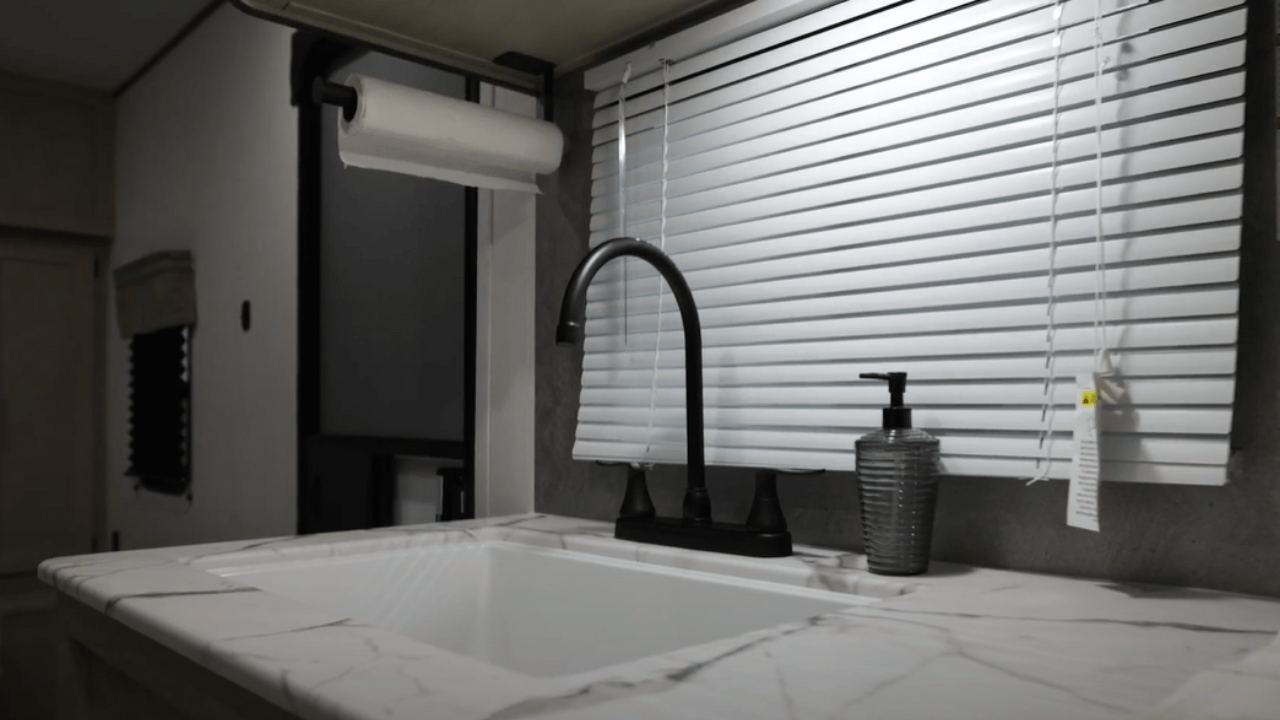Camper FAQs is reader-supported. Buying through links on our site may earn us an affiliate commission. As an Amazon Associate I earn from qualifying purchases.
Over time, grease, soap scum, and minerals accumulate in your gray tank, leading to slow drainage, unpleasant odors, and potentially even clogs. Regular rinsing helps, but it doesn’t completely remove the build-up.
There’s a simple way to fix that problem, however, and it doesn’t involve harsh chemicals or expensive tank treatments. A few common products, used the right way, can leave the tank cleaner than it’s been in years.
How to Deep Clean Your RV Gray Tank
This method doesn’t take much effort and uses items you can find almost anywhere. Let’s begin!
1. Close the gray tank valve
Keep the valve shut so the cleaning mix can sit inside the tank instead of running straight through.
2. Fill the tank halfway with warm water
Warm water helps loosen grease and soap buildup more effectively than cold.
3. Add the cleaning mix
Through the sink drain, pour in:
- 1 cup Calgon liquid water softener (or ½ cup powder)
- ½ cup Borax or ½ cup baking soda
These ingredients work together to soften water, break down grime, and reduce odor.
4. Fill the rest of the tank with fresh water
Stop before it overflows. The goal is to let the cleaning solution reach all interior surfaces and lines.
5. Let it sit overnight
Give it at least eight hours to do the work. During that time, the solution loosens the buildup that regular rinses leave behind.
6. Drain the gray tank
Open the valve and empty the contents. If the water looks darker than usual, that’s normal as it’s just the residue flushing out.
7. Rinse thoroughly
Use a gray tank flush, or refill halfway with clean water and drain again until the water runs clear.
Notes and Tips
- Clean it every few months. During regular use, a deep clean every few months keeps buildup under control and helps sensors stay accurate.
- Deep clean before storage. Cleaning the gray tank thoroughly before putting the RV away keeps residue from hardening and stops odors from forming while it sits.
- Don’t overuse additives. A small amount of Calgon or Borax does the job. Too much can create residue that takes longer to rinse out.
Why This Combination Works
Gray tank residue isn’t just food particles or grease. Over time, hard water minerals and soap scum bind together and coat the tank walls. Calgon helps by softening the water, which stops those minerals from sticking. Borax (or baking soda) raises the pH, breaking down fats and residue while neutralizing odors.
Together, they make it easier for everything to rinse away cleanly. Dish soap alone can cut grease, but doesn’t remove mineral buildup or bacteria that cause odor.
Preventing Build-Up in the First Place
Keeping debris and residue out of the gray tank makes cleaning it easier. A few simple habits go a long way:
- Wipe dishes before washing. Food scraps and grease quickly turn into buildup inside the tank. A quick wipe with a paper towel keeps most of that out.
- Use mild dish soap. Heavy, sudsy detergents create more foam and film that stick to tank walls.
- Run extra water when draining sinks or showers. The added flow helps carry soap and residue down the line instead of letting it settle.
- Keep the valve closed during camping. Letting gray water build up before dumping allows solids and residue to flush out together, rather than drying out along the sides.
- Rinse the tank regularly. Even a partial rinse between trips prevents residue from drying and sticking.
- Use strainers in the sink and shower. A kitchen sink strainer catches food scraps, and a hair strainer keeps strands from creating tangles in the shower line. Sizes vary, so double-check your drain opening before ordering.
- Clean strainers often. Lift and wipe down your sink and shower strainers periodically, picking out any scraps that slipped through.

Write a comment